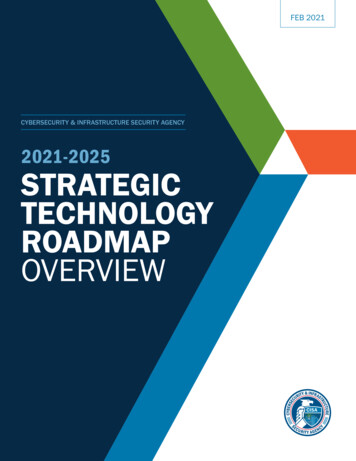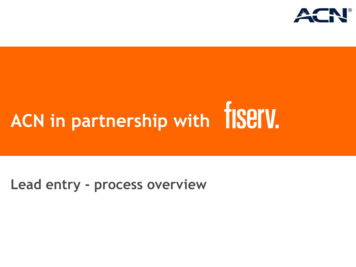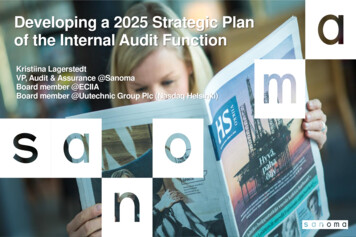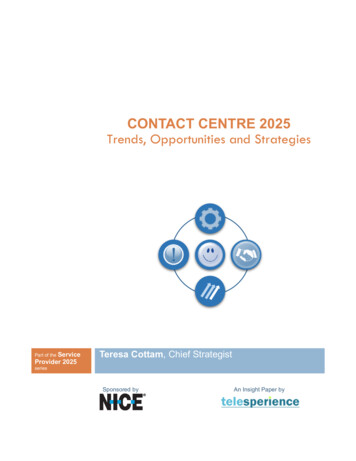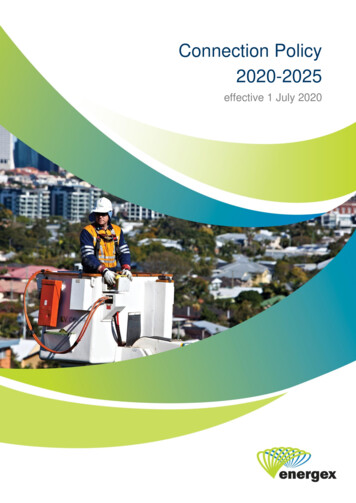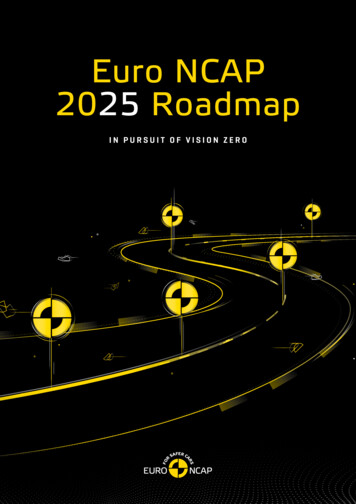
Transcription
Euro NCAP2025 RoadmapEURO NCAP 20/25 ROADMAPIN PURSUIT OF VISION ZERO1
Executive SummaryThe focus of the roadmap is on the use of advanced technology to deliver improvedpassenger car safety but also on how it might assist other road users. The continueduse of the overall rating scheme is envisaged, with its separation of assessmentinto one of four areas, but a move is proposed to a more scenario-based schemein the future and to greater use of simulation to provide a broader and more robustassessment. An assessment of automated driving is proposed, outside of themain star rating scheme. For primary safety, driver monitoring (start date 2020)is proposed, to mitigate the very significant problems of driver distraction andimpairment through alcohol, fatigue, etc. A reward is foreseen which is related bothto the problems detected by the system and to the action taken — warning in thefirst instance, but also speed limitation etc. Autonomous Emergency Steering (AES,2020) is a technology in its infancy and changes to legislation, expected in 2022, areneeded to allow full exploitation of its potential but driver-initiated, in-lane steeringsupport could be rewarded early in the roadmap period. Further developments inAutonomous Emergency Braking (AEB, 2020), to address cross-junction, head-onand reversing accidents are proposed. Finally, V2X communication (2024) offersgreat potential but agreement is first needed on the technology employed.In the field of secondary safety, a review of whiplash testing willrationalise and simplify the testing effort. For pedestrian protection,an upper-body-mass leg impactor will yield more realistic test resultswhile headform testing will be extended to include cyclists.For the first time, tertiary safety is addressed. From 2022, a reward is givenalert the owner and/or the emergency services, to avoid heatstroke fatalities.A relatively low-technology approach is proposed for assisting rescue teamsto extricate occupants from a crashed vehicle. Euro NCAP will collaboratewith CTIF to ensure the availability of standardised rescue sheets.EURO NCAP 20/25 ROADMAPto Child Presence Detection, which can detect a child left alone in a car and2
Executive SummaryAutomated driving can offer great safety potential by helping to eliminate drivererrors. Euro NCAP will promote the rapid, safe deployment of this technologyinto the vehicle fleet by means of a categorisation of the type and degree ofassistance/automation offered, outside of the main star rating scheme. At thesame time, Euro NCAP will provide information to consumers to allay fears but alsoto maintain realistic expectations of the degree of automation offered and of theneed for vigilance in cars where the level of automation is low or is not universal.Finally, in the areas of truck city safety, powered two-wheelers andcyber-security, the roadmap outlines projects with which Euro NCAPEURO NCAP 20/25 ROADMAPmay be associated whilst not necessarily taking the lead role.3
Executive Summary3Preface51/ Introduction62/ The Overall Safety Rating7Driver Monitoring (2020)Automatic Emergency Steering (2020, 2022)Autonomous Emergency Braking (2020, 2022)V2x (2024)SECONDARY SAFETYWhiplash/Rear-end Crash Protection (2020)Pedestrian and Cyclist Safety (2022)TERTIARY SAFETYRescue, Extrication and Safety (2020)Child Presence Detection (2022)778810111111111111C A R R Y- O V E R I T E M S12FUTURE EVOLUTION123/ Automated Driving13THE ROLE OF EURO NCAP13A U T O M AT E D F U N C T I O N A L I T I E S13TESTING AND ASSESSMENT13G R A D AT I O N144/ Other Initiatives15TRUCK LABEL15POWERED TWO WHEELERS15CYBER SECURITY16Timeline17References18EURO NCAP 20/25 ROADMAPPRIMARY SAFETY4
PrefaceBefore you lies Euro NCAP’s roadmap for the period between 2020 and2025. The document provides guidance on the future developments andactivities of the European consumer safety program and may serve asa reference for the automotive industry and other stakeholders.Forward planning for this transient period, where available technology andthe boundary conditions are evolving rapidly, was difficult. Over the lastmonths, Euro NCAP has reached out to key external stakeholders in theindustry to discuss our first thoughts about the future safety rating andits role in promoting automation. Debating these issues face to face hashelped us to identify the opportunities for vehicle safety improvement andbetter understand the challenges that the automotive industry is facing.Euro NCAP wishes to express its sincere gratitude to all whoparticipated in the consultation meetings and who haveprovided the very valuable feedback and suggestions.EURO NCAP 20/25 ROADMAPLeuven, 12 September 20175
1/ IntroductionAs an advocate for safer cars, Euro NCAP aims to highlightautomated driving technologies and raise awareness oftheir benefits. But Euro NCAP will also keep challengingvehicle manufacturers on what they are actually selling toconsumers on the European market. This means offeringthe best possible technology as standard in all segmentsand countries, protecting car occupants of all ages, sizesand shapes and to also look out for the safety of otherroad users in traffic.With 256 million cars in use, Europe has the world largest passenger car fleet. In 2016, over 14 million new carswere registered (ACEA, 2017). Traditionally, the smallerA- and B-segments dominate the passenger car salesin numbers, while the mid-sized Sport Utility Vehiclesegment is one of the fastest growing. Over 95 percentof new model sales in these segments are covered by arating, so it is probably fair to say that Euro NCAP hasa strong influence on the fitment and performance ofvehicle safety systems in the market.Despite having one the highest motorisation rates, roadsin Europe remain the safest in the world: in 2016, theEU-28 counted 50 road fatalities per one million inhabitants, against 174 deaths per million globally (EuropeanCommission, 2017). Car occupants account for almosthalf of road accident victims. However, all combined,pedestrians, cyclists and motorcyclists make up almostthe same share. Looking beyond the fatality number, itis estimated that 135,000 people are seriously injured onEuropean roads each year (European Commission, 2017).Indeed, most of those seriously injured are vulnerableroad users and many are elderly, an age group that isgrowing in importance.The more widespread availability and affordability ofthe technology that enables Advanced Driver AssistSystems, such as AEB and LDW, has resulted in a significant increase in the uptake of such technology in recentyears. Still, the number of cars in the fleet equipped withstate-of-the-art ADAS remains relatively low and will notyet have significantly changed common crash types orthe frequency of vehicle crashes. This is particularly truefor ADAS systems designed to address vulnerable roaduser crashes, which are only just emerging on the market.On the other hand, the widespread availability of better-established or mandatory technologies, such as sidecurtain airbags, SBR and ESC, have had a clear impacton the frequency of some fatal or injurious crashes suchas single vehicle roll-overs. In developing a longer-termagenda for vehicle safety, it is important to account forthe changes in real-world priorities and the anticipatedimpact of emerging safety technologies.Equally important is to understand how the consumermindset is changing and what it means for the car market.Last year, the average car age in Europe rose again, toover 10 years, some two years more than it was a decadeago (ACEA, 2017). This adds pressure on organisationslike Euro NCAP that advocate widespread and timelyadoption of important safety technology across theregion. The average car buyer is getting older as well, aslifespans extend and young people become less ableor willing to own a new car. Carmakers are expandingmobility services such as car sharing, in order connectyoung consumers to their brand.To stay influential and relevant in this widening landscape,vehicle safety information will not only have to appeal(and be helpful) to the traditional car buying public, butalso to other user groups or business models. The overallsafety rating, a simple yet powerful tool in communicatingabout vehicle safety, will remain one of Euro NCAP’s mostimportant output channels; however, to reach consumersin their “content cocoons” and to connect with a broadrange of potential other users, Euro NCAP will also needto develop attractive stories around safety-related topics.In the upcoming years, significant changes to the regulatory landscape and to the content of vehicle safetytype approval are anticipated. The European Commissionhas announced a revision of General Safety Regulation661/2009, potentially including several new measuresthat are part of consumer testing today (European Commission, 2016). Euro NCAP must ensure that its safetyratings will complement those developments and rewardhigher performance in a faster timescale than regulationrequires.EURO NCAP 20/25 ROADMAPIt has been said that the auto industry will change morein the next five to 10 years than it has in the last 50 andthis may very well be true for vehicle safety technology.Automated driving technologies, now rapidly developing,will transform the driving experience and the auto industryas a whole. At the same time, Europe’s inevitable shifttowards an era of electric vehicle propulsion is expectedto accelerate, with 30 percent of sales electric by 2025(UBS, 2017).6
2/ The Overall Safety RatingIt is the intention that the Overall Rating System andmethodology (van Ratingen, 2008) will remain in place,at least for the time being. It is clear, however, that thereis an increasing amount of overlap between safetytechnologies offered on the market and that there ismore than one way in which a particular crash scenariocould be dealt with in terms of injury mitigation and/oravoidance. Euro NCAP recognises the need to addressmore effectively the way in which primary, secondary(and tertiary) safety elements are integrated.During the coming years, a transition is foreseen froma “technology based” approach (e.g. tests for AEB) toa more “scenario based” assessment that would allowvarious types of interventions (e.g. braking and steering).At the same time, passive safety test methodology willbe updated to allow for pre-crash activation of restraints.This review of the overall rating methodology will alsoaddress opportunities to exploit virtual testing to addmore robustness to the assessment. This transitionprocess will phase in from 2022 and is expected to becompleted by the end of the roadmap term in 2025.Ensuring stability of the rating during this transition willbe essential.Based on the evolution of safety technology in thefleet, Euro NCAP plans to introduce several new testitems under the overall safety rating. These items maybe added or partly replace existing tests. The timescalerefers to the expected first introduction date in the ratingscheme. More details can be found in the Roadmap 2025graphical timeline (see p.17).As a final introductory remark, it should be noted thatEuro NCAP will continue to closely monitor the frequencyand nature of real-world crashes and advancements intechnology during the roadmap implementation years.Where appropriate, it will pursue available possibilitiesto test and rate important new features beyond thosethat already have been identified here. This would allowus to rapidly give credit for important safety innovations.PRIMARY SAFETYDriver Monitoring (2020)More than ninety percent of road accidents are causedby “human mistakes”. In general, two kinds of mistakescan be observed: violations, of which speeding anddriving under the influence of alcohol or drugs are mostcommon; and human “errors”, in which the driver state- inattentiveness, fatigue, distraction - and inexperienceplay an important role. In an aging society, sudden medicalincapacitation is also a growing cause of road crashes.Already, driver advisory systems such as Speed AssistanceSystems (SAS) and Attention Assist target the human element in crashes by alerting the driver in critical situationsand, ultimately, by supporting the driver to improve hisbehaviour. In addition, adapting intervention criteria toindividual drivers and the driver’s state may provide asignificant potential for earlier interventions in the futurewithout compromising false-positive levels.Euro NCAP envisages an incentive for driver monitoringsystems1 that effectively detect impaired and distracteddriving and give appropriate warning and take effectiveaction e.g. initiating a safe evasive manoeuvre, limp homemode, increased increasing sensitivity of Electronic Stability Control, lane support, speed, etc. Implementationin the overall rating is planned in phases, starting withsystems that have already entered the market. The assessment will evolve around how reliably and accuratelythe status of the driver is detected and what action thevehicle takes based on the information. Other aspects,such as driver position monitoring, could be added infuture iterations of the protocol.Effective driver monitoring will also be a prerequisite for automated driving, to make sure that, where needed, control can be handed back to a driver who isfit and able to drive the vehicle. This item will be taken on board under the HMI requirements for Automated Driving.EURO NCAP 20/25 ROADMAPEuro NCAP has already introduced some importantupdates to the crash test program in recent years andrevisions to the front and side impact tests are plannedfor 2020 (Euro NCAP, 2015). This shows that secondarysafety is and will remain at the heart of Euro NCAP’sconsumer ratings for some time. But Euro NCAP hasclearly recognised that primary safety has an increasinglyimportant role to play. As the rate of development in thisarea accelerates, the safety rating is expected to includemore and more ADAS and crash avoidance technologies
IN PURSUIT OF VISION ZERO. EURO NCAP 20/25 ROADMAP 2 The focus of the roadmap is on the use of advanced technology to deliver improved passenger car safety but also on how it might assist other road users. The continued use of the overall rating scheme is envisaged, with its separation of assessment into one of four areas, but a move is proposed to a more scenario-based scheme in the
